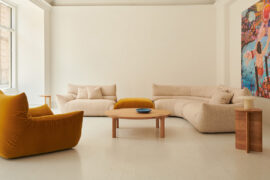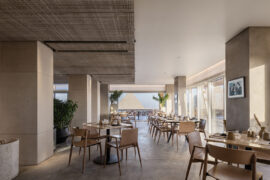The architect from China is praised for producing a body of work that opens new horizons while resonating with place and memory.
March 1st, 2012
Chinese architect Wang Shu has been announced as the winner of this year’s prestigious Pritzker Architecture Prize – often described as the ‘Nobel prize of architecture’.

Ceramic House, 2003 – 2006, Jinhua, China
Thomas J. Pritzker, chairman of The Hyatt Foundation, which sponsors the prize, explains the significance of this year’s winner.
“The fact that an architect from China has been selected by the jury represents a significant step in acknowledging the role that China will play in the development of architectural ideals. In addition, over the coming decades China’s success at urbanisation will be important to China and to the world… China’s unprecedented opportunities for urban planning and design will want to be in harmony with both its long and unique traditions of the past and with its future needs for sustainable development.”

Xiangshan Campus, China Academy of Art, Phase I, 2002 – 2004, Hangzhou, China
Pritzker Prize jury chairman The Lord Palumbo says that Wang’s work is able to transcend the current debate “as to whether architecture should be anchored in tradition or should look only toward the future”. Wang’s work, he says, is “timeless, deeply rooted in its context and yet universal”.

Xiangshan Campus, China Academy of Art, Phase I
The 48-year-old architect runs Hangzhou-based “Amateur Architecture Studio” with his wife, Lu Wenyu, where traditional understanding, experimental building tactics, and intensive research form the basis of their work.

Ningbo History Museum, 2003 – 2008, Ningbo, China
His completed projects include the Library of Wenzheng College at Suzhou University, Ningbo Contemporary Art Museum, Ningbo History Museum, Xingshan Campus of the China Academy of Art, Vertical Courtyard Apartments, and the Ceramic House.

Ningbo History Museum
International accolades include the French Gold Medal from the Academy of Architecture in 2011, and the German Schelling Architecture Prize in 2010 – a joint award with his wife.

Ningbo Tengtou Pavilion (2010), Shanghai Expo, China
Wang Shu has expressed considerable surprise at his win, saying that he is greatly honoured. “I suddenly realised that I’ve done many things over the last decade. It proves that earnest hard work and persistence lead to positive outcomes.”
Past Pritzker Prize laureates include Frank Gehry (US), Zaha Hadid (UK), Rem Koolhaas (the Netherlands), Renzo Piano (Italy), Jean Nouvel (France), Glenn Murcutt (Aus) and, just last year, Eduardo Souto de Moura (Portugal).
Wang Shu will be a keynote speaker at experience, the National Architecture Conference to be held in Brisbane from May 10-12.
The Pritzker Architecture Prize
pritzkerprize.com
INDESIGN is on instagram
Follow @indesignlive
A searchable and comprehensive guide for specifying leading products and their suppliers
Keep up to date with the latest and greatest from our industry BFF's!

A longstanding partnership turns a historic city into a hub for emerging talent

A curated exhibition in Frederiksstaden captures the spirit of Australian design

The undeniable thread connecting Herman Miller and Knoll’s design legacies across the decades now finds its profound physical embodiment at MillerKnoll’s new Design Yard Archives.

For Aidan Mawhinney, the secret ingredient to Living Edge’s success “comes down to people, product and place.” As the brand celebrates a significant 25-year milestone, it’s that commitment to authentic, sustainable design – and the people behind it all – that continues to anchor its legacy.

Furnished Forever is a commercial furniture studio founded in 2017 by Canberra-based designers René Linssen and Elliot Bastianon. We talk to the partnership to find out how Furnished Forever started and what makes it special…

The start of the 2016 school term this month sees Perth peak period commuters dealing with up to 20 per cent of added private vehicle traffic on our roads.

Melbourne born and world acclaimed contemporary artist James Reka’s sensational art bath, the hit of the Maison et Objet design show during Singapore Design Week earlier this year, is to be unveiled in Richmond at apaiser bathware this month.

What is interior design’s responsibility in revolutionising aged-care environments? The new Emmy Monash Aged-Care facility in Melbourne’s Caufield has all the luxury commodities of a contemporary multi-residential complex. From thoughtfully considered finishes through to superior shared facilities, no expense has been spared on residents’ comfort and quality of life.
The internet never sleeps! Here's the stuff you might have missed

Pedrali’s Nemea collection, designed by Cazzaniga Mandelli Pagliarulo, marks 10 years of refined presence in hospitality and commercial spaces around the world. With its sculptural timber form and enduring versatility, Nemea proves that timeless design is never out of place.

Poliform has mastered the art of seating that is both elegant and adaptable. These five designs highlight the balance between aesthetic impact and everyday ease.

Projects and people from across our region were certainly prominent at the 2025 INDE.Awards gala and in particular, Aotearoa/New Zealand, Singapore and Thailand made their presence felt.

The INDE.Awards 2025 has crowned Sirius Redevelopment by BVN as the winner of The Multi-Residential Building, sponsored by CULT. This ambitious project redefines urban living in Sydney’s historic Rocks precinct while preserving heritage, reducing embodied carbon, and elevating residential design.